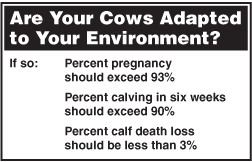



Adaptability, Body Condition Closely Connected
By Kris Ringwall, Beef Specialist, NDSU Extension Service. Research has shown that body condition is the No.1 indicator on the ability of a cow to calf.
One of the keys to surviving in the cow-calf business is adaptability, which is determined by how well one’s cows fit the environment they live in. Last week, cattle hair was discussed, but hair only is one factor used to gauge adaptability.
At the onset, baseline reproductive performance must be known. The herd pregnancy rate should be 93 percent or more. A goal should be set that more than 95 percent of the cows exposed to the bull last year should be ready to calve or already have calved this year.
Nonpregnant cows are not adapting to the local conditions and need to leave. Another indicator of adaptability is calving distribution. Two-thirds of the cows should calve within three weeks of the start of the calving season and 90 percent should have calved within six weeks.
Both numbers are easy to calculate because one should know the total number of cows turned out to the bull and the number of cows calving should be in the calving book. The number calving within the first three weeks can be counted once the cows are recorded in the calving book.
The North Dakota Beef Cattle Improvement Association will provide you a free calving book. Call (701) 483-2348 , ext. 105, or e-mail [email protected]. You also can write for the book at NDBCIA, 1041 State Ave., Dickinson, ND 58601.
Excuses for the lack of adaptability are frivolous. The combination of many traits creates the genetic code for the right cow, but even the right cow needs to be fed.
A note of caution certainly is required as one reflects on how nice the winter, at least in western North Dakota, has been. Above-normal temperatures and minimal snow cover have been the norm.
However, with good weather, the downside is that producers tend to let cows or calves run longer on fall pasture or crop residue. The end result is a loss in body condition and thin cows in the winter.
The growing season is what should determine pasture availability, not the lack of snow. Although not the best technique, drive-by evaluations of cow body condition showed more than an average number of cows in thin condition as the year ended.
Research has shown that body condition is the No.1 indicator on the ability of a cow to calf, rebreed and maintain a 365-day calving interval. After fall weaning is an excellent time to allow thin cows to gain some condition. Winter will work as well.
Remember, if the cow is thin, she needs to gain weight for her sake and her unborn calf. Upon birth, the best colostrum is needed in that first drink so the calf doesn’t have to play Russian roulette with an army of invading thugs, such as bacteria and viruses.
One does not like it, but the thugs probably still will get 1 percent to 3 percent of the calves. Any death loss of more than 3 percent is too high. The goal, although not realistic, should be no death loss.
Thin cows can stretch, but spring calving generally is a month to two months before cool-season pastures are ready. Act now. Thin cows need a nutritional plan developed through consultations with a good nutritionist.
However, in terms of adaptability, some cars are gas guzzlers and some are more efficient. The same is true for cows.
Keep an eye out for those efficient cows. The efficient cows probably will be camouflaged by a good coat of winter hair, but understanding cow body condition under the hair also must not be forgotten.
Cow condition probably is the most critical component to understanding the nutritional status of the herd. So, for today, check the hay reserve and supplements. If the cows are thin, increase their intake.
May you find all your ear tags.
February 2008


